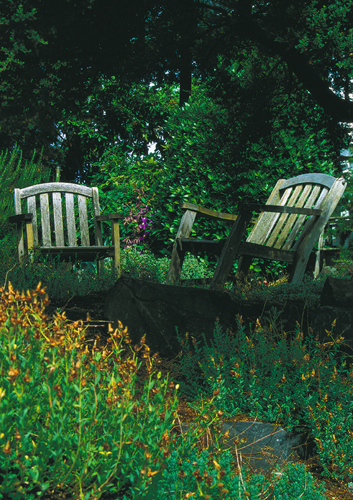Planting Summer Containers
By Nadine Black
This is not your usual "how to" article. I am going to give you some factual information, but this is really about getting your imagination going.
When you close your eyes and imagine a container for your summer garden, what do you see? When I ask myself this question, my answer seems to be a regurgitation of what I've just seen in the latest magazine I've looked at. I want to break away from that habit. How about you?
OK, where do we start? I think, with the purpose of the pot. It is to enhance and excite my outdoor living space for the summer. What size do I want? Will it rest on a pedestal? Do I want bright colors? Is it for sun or shade? How do I water it? Do I want to put plants in to extend the interest beyond the summer. Yes, this is a pop quiz! I always make my customers consider their answers to these questions before the fun starts. You'd be amazed how much time and money you can save by doing a little "homework."
 I'm going to do two pots in detail and then make some suggestions for others. The first pot is a large (40 inch) terra cotta pot. It will be placed in partial shade. The pot will be seen occasionally during the winter since it will be difficult to move. This means some of the plants must be perennial and have some winter interest.
I'm going to do two pots in detail and then make some suggestions for others. The first pot is a large (40 inch) terra cotta pot. It will be placed in partial shade. The pot will be seen occasionally during the winter since it will be difficult to move. This means some of the plants must be perennial and have some winter interest.
The most important thing, however, is that it be "smashing" during the summer. The anchor plant in this pot will be Acer japonica 'Orangeola' which has orange tipped new growth and sunset orange fall color. It is also a slow growing dwarf and will live in this pot for a long time. Next is Fuchsia 'Thalia' (above) with its fire-cracker orange blooms that continue all summer. The foliage on this plant is bronze/burgundy.
 In two places, I am planting five Heuchera 'Marmalade' (at left) whose foliage echoes the orange tints of the maple. This plant is evergreen, so it will have some presence during the winter. Now, for the "smashing" part. To me, great impact means lots of contrast. In this case, I mean color contrast. The relatively "blendy" color combination I've described so far will become enlivened with the addition of citron yellow Coleus and bright pink 'Pink Madness' petunias. Finally, right at the base of the maple, I'm planting a blood-red Rex-type Begonia.
In two places, I am planting five Heuchera 'Marmalade' (at left) whose foliage echoes the orange tints of the maple. This plant is evergreen, so it will have some presence during the winter. Now, for the "smashing" part. To me, great impact means lots of contrast. In this case, I mean color contrast. The relatively "blendy" color combination I've described so far will become enlivened with the addition of citron yellow Coleus and bright pink 'Pink Madness' petunias. Finally, right at the base of the maple, I'm planting a blood-red Rex-type Begonia.

The second pot will be a hanging basket for sun. I'll begin with Verbena 'Homestead Purple' which loves heat and blooms all summer. Be sure to groom it regularly to keep the flowers coming. Fuchsia 'Lena' (at right) with its purple and white flowers, echoes the verbena. (You may think fuchsias are shade plants but they do fine in sun in the Pacific Northwest as long as adequate water is provided.) In order to provide some texture variation, I'm adding Ajuga 'Catlin's Giant.' This ground-cover has a wide burgundy leaf and sports purple-blue flower spikes. For added interest, I'm going to slip in a dwarf conifer called Cryptomeria japonica 'Compacta.' This evergreen has gray green summer foliage that turns a copper color in winter.
So, to review, create contrast either with texture or color or both; try plant groups you don't normally associate with containers, i.e., house plants, dwarf trees, conifers and shrubs; go tropical or Mediterranean (you know you've wanted to!) - bananas, palms, cannas, echiverias, and agaves lend an air of mystery and the feeling of being in a different place.
Here are some practical considerations. If you are using perennials and plan to make the container permanent, mix compost into your potting soil. Potting soil is sterile and provides no nutrition to the plants. Use a balanced slow release fertilizer for basic needs and a bloom booster for consistent color. In order to be sure the smaller pots or hanging pots don't dry out, mix a moisture-holding polymer such as Soil Moist into your soil before planting. Finally, enjoy your containers from the planning to the final product.
Nadine Black tried on many hats in our industry - from private gardener to wholesale plant sales - before she discovered that her real passion was helping retail customers create gardens. At Joy Creek Nursery, she has found a new set of hats, managing retail sales, conducting on-site garden consultations, and teaching workshops. In addition, she has acquired the Lifetime Certified Oregon Nursery Professional certificate from the Oregon Association of Nurseries.
© 2007 Joy Creek Nursery
Photo: Joy Creek Photo Archive © all rights reserved
Labels: Article, container gardening, horticulture, Joy Creek, Perennials, planting in pots, plants


0 Comments:
Post a Comment
Subscribe to Post Comments [Atom]
<< Home